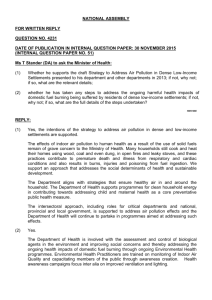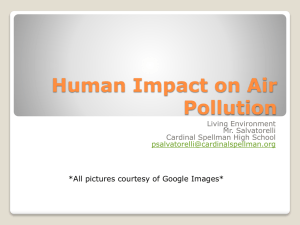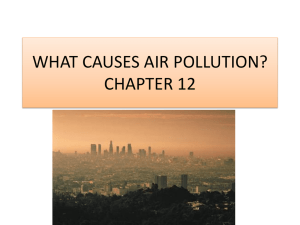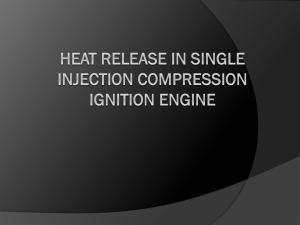ppt - Chapter 9
advertisement
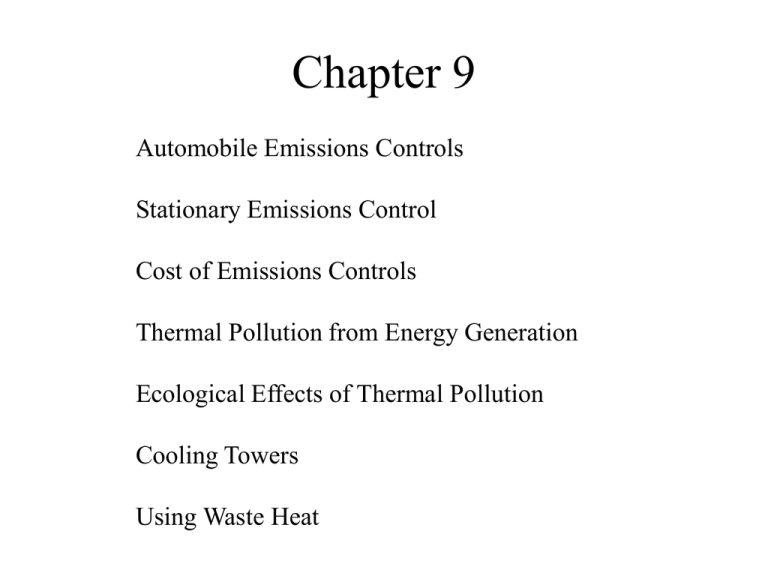
Chapter 9 Automobile Emissions Controls Stationary Emissions Control Cost of Emissions Controls Thermal Pollution from Energy Generation Ecological Effects of Thermal Pollution Cooling Towers Using Waste Heat Energy in the News Thursday Energy Roundtable at SIPA Cancelled: Not yet rescheduled Automobile Emissions Controls Emissions can be controlled in several ways Change the fuel used by the car Change the way that the engine burns the fuel Decrease the use of cars by subsidizing mass transit Changing the Fuel What are other names for methanol, ethanol and compressed gas? How are they made? Other drawbacks of these fuels? The Newest Fuel: Nitrogen Newest alternative fuel (reported this Monday) Works by using decompression of Liquid nitrogen to Push pistons and run The car engine. No pollutants at all, BUT Technology not mature. Changing the Burning Process More efficient cars emit less CO2 per mile traveled. (In the 1970s, estimated that could run All cars on ethanol and methanol derived from Fermented biomass if all cars averaged 60 miles Per gallon.) Number is out of date, but at some gas mileage It is possible to run all cars on renewable sources Of hydrocarbons. Amory Lovins: using the best technology: Could potentially build cars That get 150 miles per gallon. Positive Crankcase Ventilation At the edges of the combustion Chamber of the engine (above the piston tops), there is a thin layer of gasoline that does Not burn up. This gasoline Constitutes an air pollutant (what is its classification?) To keep gasoline from returning to The air, this gasoline is recirculated Back into the combustion chamber. Exhaust Gas Recirculation Exhaust gases are Removed from the Crankcase and then Recirculated back into The carburetor. Other Pollution Controls Minimize CO and hydrocarbons by improving burning Of the fuel. To improve burning: use leaner fuels and increase Temperatures in the combustion chamber. Leaner fuels: means mixture of air plus fuel has more Air and less fuel. But leaner fuels increase Nox formation because Burning is at higher temperatures and more oxygen is Available to form Nox. Catalytic converters: help to get around these problems. They require unleaded gasoline. Automobile Emissions Standards Standards met by using catalytic converters, engine Redesign and additives (MBTE, other oxidants). Mass Transit Shin Kan Sen (Bullet Train), TGV (Train Grande Vitesse) Both are MAGLEV (magnetic levitation) trains Travel at up to 300 km/hr (180 mph) Shin Kan Sen: Trains leave every 3 hours: Tokyo-Kyoto TGV-not so often Buses like subways(pay fare before getting on in enclosed area) Most efficient form of public transport Exist in Brazil Biggest problem: Load factor If not used enough, mass transit is LESS energy efficient than cars 90% of public funds in US used to build highways True Energy Use by Transportation In theory, a train Is 15 times more Energy efficient than A car. Considering load Factors, what is The more typical Ratio of efficiency? What is the most Energy efficient Transportation? Reducing Pollution from Stationary Sources How pollution is reduced; 1) Change the fuel 2) Change how the fuels burns 3) Remove pollutants after burning Other methods don’t really reduce overall pollution, they Shift it in time or in space, what are these methods? Shifting the Pollution in Space Sudbury Ontario: giant astrobleme-Worlds biggest Ni mine One of two oldest meteorite impact structures: 1.8 Ga (1800 Ma) (Canadian Nickels) Ni is a heavy metal; large quantities Are poisonous to people and plants. What did building a Taller smoke stack at Sudbury do to the landscape? (Dumping the slag) Shifting the Pollution in Time Why does shifting the time at which emissions are made Affect the resulting air quality? (Ozone for example). Other strategies not so nice. (At U.S. Mexican border). El Paso area? Removing the Pollution Mary Walton invented an early pollution control device For factories. Power Plant Pollution Control What is being Removed by The electrostatic Precipitator? By the wet Scrubber? Fluidized Bed Combustion Key Reaction: CaO (lime) + 1/2O2 +SO2 = CaSO4 (calcium sulfate) Limestone = CaCO3 What else besides calcium sulfate Is emitted by Fluidized Bed Combustion (FBC)? FBC reduces NOx by lowering Temperature of burning Cleaning the Coal by Crushing and Settling FeS2 or pyrite (fools gold): Very dense. Can separate from coal using Settling techniques. Why? This cleans the coal of part Of its sulfur. Remaining sulfur: chemically Bonded with the coal. Cost of Pollution Controls Cost of pollution controls Left: normalized to 100% Cost for all pollution Controls Right: as a percentage of Total power plant cost (only one line is relevant) Actual cost: typically About 1/3 of plant cost Physics of Waste Heat Q = m* c* deltaT Q is heat added, m is mass, c is specific heat Delta T is the temperature change What is waste heat? Why do you get always get waste heat when You generate power using a heat engine? Waste Heat and Water Use Which users are Increasing their water consumption the most? 1855 to 1980? 1980 to 2000? (Graph is for the United States) Why? Waste Heat from Power Plants Which portion of the waste heat goes to heat up water In a water-cooled plant? Which plant type generates The most waste heat per unit of power output? Dissolved Oxygen in Water vs T How does the amount Of dissolved oxygen in The water change as a Function of temperature? Why? PV=nRT Oxygen Consumption of Fish vs T Why do fish need more oxygen As the temperature of the water Increases? Given the solubility of oxygen In water as a function of temperature (in the previous slide), what happens to the fish if the water gets too hot? Why would it be difficult to publish This graph? Fish: Response to Temperature Solid dot: Upper lethal Limit for a Given species Open dot: Best T for spawning Solid blocks: Preferred Temperature Range Temperature and Growth of Food Animals What is the optimum Temperature for Hens, catfish, shrimp? Thermal Pollution from Power Plants Eutrophication: Natural aging of Lakes Promoted by waste Heat from power Plants. Why? Natural Draft Cooling Tower Why does this cooling Tower lack a fan? Mechanical Draft Cooling Tower Why does this tower Need a fan? (Active vs Passive Cooling Tower) Air to Liquid Heat Exchanger What is the Heat being Extracted from? Why? Recuperator: Also extracts heat Why is it useful to heat incoming Air and cool outgoing air (this is a heat engine)? Uses of Waste Heat Cogeneration Aquaculture Greenhouse heating Desalination of seawater Increase crop growth in cold season Preheat air Other??
